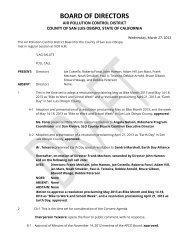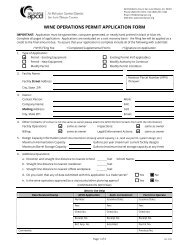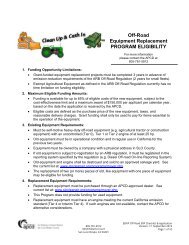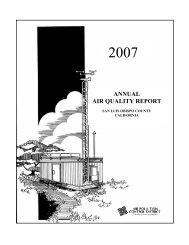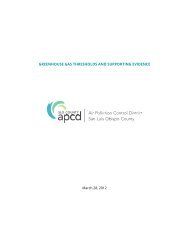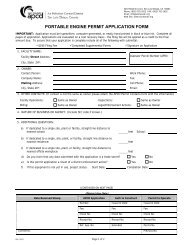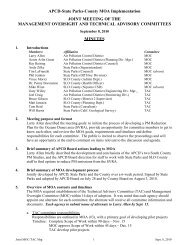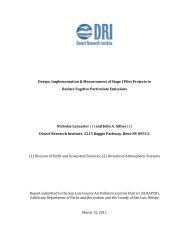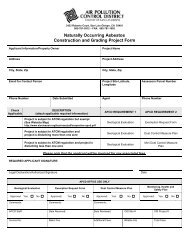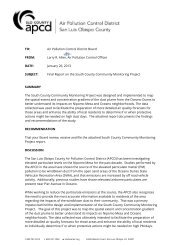CEQA Air Quality Handbook - Air Pollution Control District
CEQA Air Quality Handbook - Air Pollution Control District
CEQA Air Quality Handbook - Air Pollution Control District
You also want an ePaper? Increase the reach of your titles
YUMPU automatically turns print PDFs into web optimized ePapers that Google loves.
SLO County APCD <strong>CEQA</strong> <strong>Air</strong> <strong>Quality</strong> <strong>Handbook</strong> 2012<br />
§15183.5. Tiering and Streamlining the Analysis of Greenhouse Gas Emissions.<br />
(a) Lead agencies may analyze and mitigate the significant effects of greenhouse gas emissions at a<br />
programmatic level, such as in a general plan, a long range development plan, or a separate plan to<br />
reduce greenhouse gas emissions. Later project-specific environmental documents may tier from<br />
and/or incorporate by reference that existing programmatic review. Project-specific environmental<br />
documents may rely on an EIR containing a programmatic analysis of greenhouse gas emissions as<br />
provided in section 15152 (tiering), 15167 (staged EIRs) 15168 (program EIRs), 15175-15179.5<br />
(Master EIRs), 15182 (EIRs Prepared for Specific Plans), and 15183 (EIRs Prepared for General<br />
Plans, Community Plans, or Zoning).<br />
(b) Plans for the Reduction of Greenhouse Gas Emissions. Public agencies may choose to analyze and<br />
mitigate significant greenhouse gas emissions in a plan for the reduction of greenhouse gas emissions<br />
or similar document. A plan to reduce greenhouse gas emissions may be used in a cumulative impacts<br />
analysis as set forth below. Pursuant to sections 15064(h)(3) and 15130(d), a lead agency may<br />
determine that a project’s incremental contribution to a cumulative effect is not cumulatively<br />
considerable if the project complies with the requirements in a previously adopted plan or mitigation<br />
program under specified circumstances.<br />
(1) Plan Elements. A plan for the reduction of greenhouse gas emissions should:<br />
(A) Quantify greenhouse gas emissions, both existing and projected over a specified time period,<br />
resulting from activities within a defined geographic area;<br />
(B) Establish a level, based on substantial evidence, below which the contribution to greenhouse gas<br />
emissions from activities covered by the plan would not be cumulatively considerable;<br />
(C) Identify and analyze the greenhouse gas emissions resulting from specific actions or categories of<br />
actions anticipated within the geographic area;<br />
(D) Specify measures or a group of measures, including performance standards, that substantial<br />
evidence demonstrates, if implemented on a project-by-project basis, would collectively achieve the<br />
specified emissions level;<br />
(E) Establish a mechanism to monitor the plan’s progress toward achieving the level and to require<br />
amendment if the plan is not achieving specified levels;<br />
(F) Be adopted in a public process following environmental review<br />
(2) Use with Later Activities. A plan for the reduction of greenhouse gas emissions, once adopted<br />
following certification of an EIR or adoption of an environmental document, may be used in the<br />
cumulative impacts analysis of later projects. An environmental document that relies on a greenhouse<br />
gas reduction plan for a cumulative impacts analysis must identify those requirements specified in the<br />
plan that apply to the project, and, if those requirements are not otherwise binding and enforceable,<br />
incorporate those requirements as mitigation measures applicable to the project. If there is substantial<br />
evidence that the effects of a particular project may be cumulatively considerable notwithstanding the<br />
project’s compliance with the specified requirements in the plan for the reduction of greenhouse gas<br />
emissions, an EIR must be prepared for the project.<br />
Detailed information on preparing qualified GHG reduction plans is provided in the Technical<br />
Appendices 4.6 GHG Plan Level Guidance.<br />
3-2



